Kuala Lumpur, the vibrant capital of Malaysia, is a bustling metropolis where access to emergency medical services is crucial. In situations where every second counts, knowing the available ambulance services, their contact numbers, and the types of services they offer can make a significant difference. If you ever find yourself in a medical crisis, remember to dial the ambulance number ‘near me’ in Kuala Lumpur, Malaysia, for immediate assistance. This comprehensive guide aims to provide an overview of various ambulance services in Kuala Lumpur, helping residents and visitors navigate emergency situations more effectively.
The Importance of Ambulance Services
Ambulance services play a vital role in the healthcare system, providing essential medical assistance and transportation to individuals in need. In Kuala Lumpur, these services cater to various emergencies, ranging from life-threatening situations to non-emergency medical transport. Understanding the available options can help ensure timely and appropriate care during critical times.
Types of Ambulance Services
In Kuala Lumpur, ambulance services can be broadly categorized into two main types:
- Emergency Ambulance Services: These are equipped to handle life-threatening situations, providing immediate medical attention and transport to hospitals.
- Non-Emergency Ambulance Services: These cater to patients who require transport for medical appointments, hospital discharges, or transfers between facilities but do not need urgent care.
Emergency Ambulance Services
Emergency ambulance services are typically available through both government and private providers. Here are some key features to consider:
Contact Numbers
In Malaysia, the general emergency number is 999. This number connects you to various emergency services, including ambulance support. It’s essential to have this number easily accessible.
Services Offered
Emergency services are equipped with trained medical personnel and necessary medical equipment. They respond to various medical emergencies, including trauma, cardiac events, and other life-threatening conditions.
Response Time
The average response time for emergency ambulances is typically around 10-15 minutes, depending on traffic conditions and the location of the emergency. Always be prepared to provide your exact location to ensure a swift response.
Non-Emergency Ambulance Services
Non-emergency ambulance services are essential for patients who need transportation but are not facing immediate medical threats. Here are some notable features:
Contact Numbers
While specific contact numbers vary by provider, several companies offer non-emergency transport services throughout Kuala Lumpur. These numbers can usually be found online or through local directories.
Services Offered
Non-emergency services include patient transfers for medical appointments, hospital discharges, and inter-facility transfers. These ambulances are often staffed by trained personnel who ensure patient comfort and safety during transport.
Response Time
Response times for non-emergency services can vary, typically ranging from 30 minutes to an hour, depending on demand and availability.
Specialized Ambulance Services
In addition to general ambulance services, Kuala Lumpur has specialized services that cater to specific medical needs:
Air Ambulance Services
- Providers: Various private companies offer air ambulance services for critical patients requiring rapid transport across longer distances. These services are typically used for inter-hospital transfers, especially in emergencies where road transport may take too long.
- Contact: Specific companies can be found online, and arrangements are usually made through hospitals or emergency services.
Pediatric and Neonatal Ambulances
- Providers: Some services offer specialized ambulances designed for transporting children and newborns. These ambulances are equipped with pediatric medical equipment and staff trained in child care.
- Contact: Always check with specific providers for availability and contact details.
How to Request an Ambulance
In emergencies, knowing how to request an ambulance is crucial. Here are steps to follow:
- Dial the Emergency Number: In Malaysia, the emergency number is 999. This connects you to various emergency services, including ambulance providers.
- Provide Essential Information: When connected, be ready to provide:
- Your location (be as specific as possible)
- The nature of the emergency
- Any relevant medical history or conditions
- The number of people needing assistance
- Stay Calm: Keep calm and follow the operator’s instructions. They may provide guidance on how to assist the patient until help arrives.
Tips for Using Ambulance Services Effectively
- Know Your Location: Being aware of your exact location can help emergency services reach you quickly.
- Keep Emergency Numbers Handy: Save important ambulance contact numbers in your phone or have them visible in your home.
- Educate Family and Friends: Ensure that those close to you know how to request an ambulance and understand your medical needs.
- Follow-Up Care: After being transported to a facility, ensure that you have follow-up care arranged, especially if you require ongoing treatment.
Community Initiatives
In Kuala Lumpur, various community initiatives focus on enhancing emergency preparedness. Local organizations often conduct workshops and seminars on first aid, CPR, and emergency response. Participating in these initiatives can help you become more informed and prepared for emergencies, while also contributing to community resilience.
Conclusion
Understanding the various ambulance services available in Kuala Lumpur, including their contact numbers, services offered, and response times, is vital for ensuring quick and effective medical assistance during emergencies. Being prepared and knowledgeable can significantly impact outcomes in critical situations. By familiarizing yourself with these services and knowing how to access them, you can contribute to a safer community and ensure that help is always just a call away. Whether facing an emergency or requiring non-urgent medical transport, having this information at your fingertips can make all the difference.

